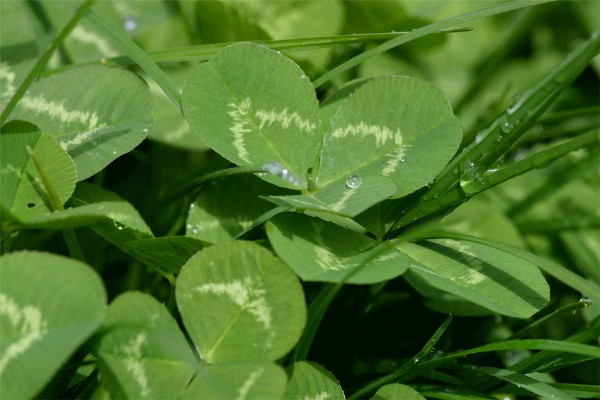

Self-sufficient leys that provide high protein grazing. The benefits derived from clover are proportional to the amount in the sward.
In the UK the most important forage legume is white clover. It is the engine in many fields, with millions of plants working 24 hours a day. It is the most flexible forage legume, providing reliable production for grazing as well as for silage. Due to the large acreage grown, it is, without doubt, the most generous provider of home grown protein underpining soil fertility strategies for dairy, sheep and beef producers.
White clover and other nitrogen fixing legumes can reduce or replace the need for costly artificial nitrogen.
White Clover is Your Flexible Friend
Some legumes are quite specific in their application. Lucerne for example is clearly suited to cutting, offering little benefit to the grazier. However, white clover is adaptable and, although fundamentally a grazing plant, it can also provide a useful silage crop. White clover is the most popular forage legume and lasts longer than the more erect red clover. White clover yields a third less than red, but has a lower growth habit that makes it ideal for grazing and this should be considered its principle use.
How Much Clover is Needed in the Sward?
The aim is to produce a sward which contains enough clover to fix 200 kg N per hectare. This means 30-50% white clover and the right balance of clover to grass throughout the year. This balance varies through the growing season, with clover at its strongest during late summer. When the sward contains enough clover it is possible to achieve yields of 13 t DM per hectare. Certainly white clover leys can produce the same yield as grass-only leys and without nitrogen fertiliser. Where possible allow an interval of about 25-35 days between defoliations. This gap allows the clover to fix the optimum level of nitrogen. Most nitrogen is fixed during the later stages of growth, therefore early defoliation restricts nitrogen fixation.
Any fall in grass quality during this extended grazing interval is more than offset by the higher feed value of the clover. Also, rather surprisingly, we have encountered less bloat on these mature swards.
Productive Livestock
White clover has a high protein content at around 27%. Perennial ryegrass contains about 17%. Combining these two together in the field increases the overall protein content of forage by 2-3% to around 20%. The extra protein available from clover leys has a direct impact on live weight gains. At the same time, grazing animals consume more as they find clover very palatable. This all results in animals fattening faster compared to those on non-clover leys.
A Veritable 57 Varieties
There is a large range of white clovers available, classified by leaf size. In general terms, the smaller the leaf, the more tolerant of close grazing. The medium-leaved varieties are more productive especially when cut for silage or hay. Although large-leaved strains give slightly higher yields they are less persistent when grazed and are therefore for cutting use only. We advise the use of modern varieties, such as Crusader and Aberherald, as they grow earlier in the spring and are more persistent than oldervarieties such as ‘Huia’.
Sowing & Establishment
White clover grows on all but the most waterlogged soils. It is important to correct any phosphate or potash deficiencies, with target levels of soil index 2. White clover does not like very acidic soil but will grow down to pH5.6. Seed can be sown between March and September. A very firm seed bed is required as white clover seeds are small and benefit from shallow sowing at around 10mm. (You should be able to ride a bicycle across the field before sowing!) Rolling at least once after sowing is strongly recommended. If under-sowing, do not choose a thick crop as this will result in failure. A thinly sown spring cereal is ideal. A clover seed mix is best sown by broadcasting with a spinner but can also be sown with a proper grass seed drill. If sowing in the autumn, aim to sow by mid September.
Bloat
One of the reasons most commonly cited for not growing clover is the risk of bloat. Concern is expressed by dairy and beef farmers when considering high-clover leys for grazing. Although cases of bloat are not common, they are distressing when they occur. Preventative measures should be taken to minimise risk. Animals should be gradually introduced to clover in the diet by limiting the amount of time spent grazing and should be fed dry materials such as hay before turnout. Those on free-draining, alkaline soil may consider including sainfoin in clover grazing leys to offset the risk.
Pochon Leys
The ley mixtures on these pages are based on the original ideas of Andre Pochon, a Breton farmer who developed a rotational grazing system using white clover and perennial ryegrass leys. These leys proved highly successful and have been adopted by many farmers since. We offer two mixtures, one for cutting and grazing, and one for long term grazing.
Date Posted: 30th March 2017



